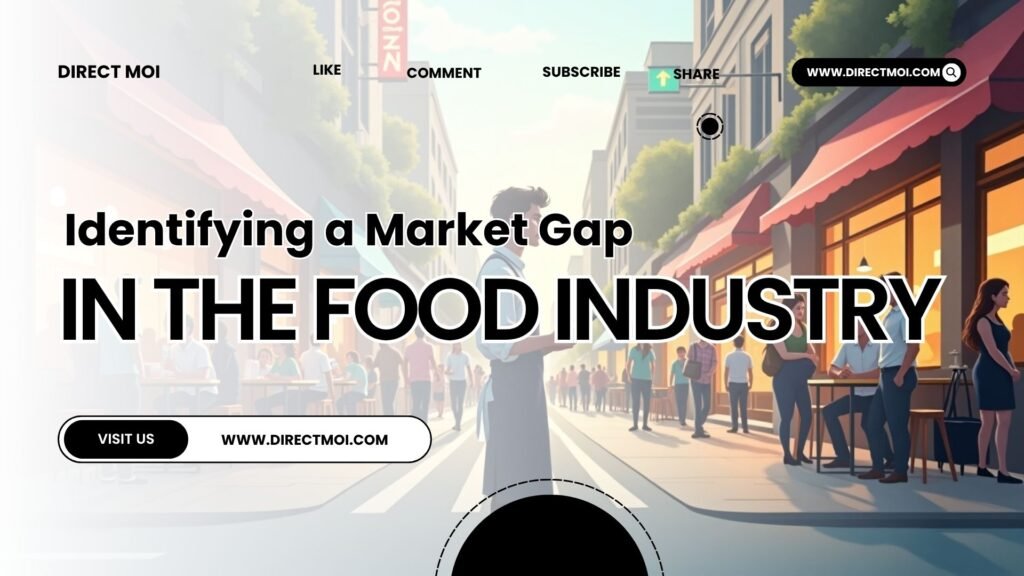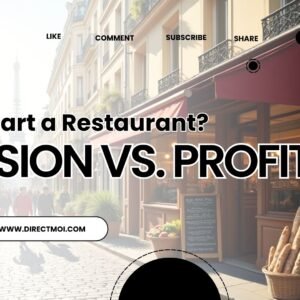
Why Read This Blog?
If you’re thinking about starting a restaurant, this episode is a crucial step: discovering your unique space in a crowded market. Instead of guessing what people want, learn how to observe, analyze, and uncover what’s missing. This story-led guide will help you see what others overlook — and position your restaurant as the solution your customers didn’t even know they needed.
Identifying a Market Gap in the Food Industry
“If everyone’s serving something, what’s not being served?”
Hello and welcome to Direct Moi. Today’s topic is all about ” Identifying a Market Gap in the Food Industry ” let’s dive in.
Imagine walking down a busy street at noon.
The air is filled with aroma — butter, spice, garlic, and freshly baked bread.
Cafés buzz, patios brim with chatter, menus dangle from glass windows.
To the untrained eye, the market seems saturated.
But then, you notice subtle details.
A mother with a child scans menus, looking for dairy-free options — none in sight.
A student browses for healthy meals under €10 — all he finds is fast food.
A traveler stares blankly at a menu in a foreign language — no translation available.
A group of coworkers wish for a quiet space to work and eat — the noise is deafening everywhere.
This is the market gap.
Not the visible, but the invisible.
Not what’s being served, but what’s missing.
While others are copying what’s trending, you have the opportunity to listen deeply.
To observe behaviors, frustrations, silent wishes.
To step into the market not just as a business owner — but as a problem solver.
Imagine a small, calm café that serves healthy, affordable, allergy-conscious meals.
With multilingual menus, Wi-Fi, and calm lighting.
It may not follow the latest TikTok food trend — but it serves a real, unmet need.
That is your golden window.
A market gap isn’t always flashy. It’s often quiet, overlooked, waiting.
And if you build a restaurant that meets that need — you’re not just opening doors.
You’re opening hearts.
Key Takeaways
To find your space in the food industry, stop asking,
“What’s trending?”
Start asking,
“What’s missing?”
Observe the daily frustrations. The silent problems. The untold stories.
And offer something meaningful, not just marketable.
Common Pitfalls to Avoid
- Jumping on a trend without market fit
- Trends may seem exciting but might not work in your location or resonate with your audience.
- Choosing a cuisine you don’t personally connect with
- If you’re not passionate or knowledgeable about it, the inauthenticity will show — to your team and your guests.
- Offering a menu that’s too broad or unfocused
- Trying to please everyone often leads to a confusing identity and high operational costs.
- Ignoring how your chosen cuisine will affect operations, suppliers, and staff
- Certain cuisines require specialized ingredients, training, and kitchen design. Factor that into your decision early.
Frequently Asked Questions
Q: Should I go with what’s popular right now?
A: Trends can work — but only if they suit your audience and you can sustain them. Depth and purpose beat short-term hype.
Q: Is traditional cuisine boring?
A: Absolutely not. Storytelling, modern plating, and immersive ambiance can bring new life to traditional food.
Q: Can I combine both trend and tradition?
A: Yes! Fusion concepts or modern interpretations of heritage dishes are popular — when done thoughtfully.
Q: How do I know if my cuisine choice will work?
A: Test it. Host small pop-up tastings, run surveys, or offer a limited menu online to gather feedback before scaling.
Exercise
Take 10 minutes to complete this quick alignment check:
- List 3 cuisines you genuinely love and feel connected to.
- List 3 food trends that inspire you.
- Circle items that overlap with your story, skillset, and your ideal customer.
- Sketch a sample dish or menu concept combining your top picks.
- Ask 3 people from your target audience what they think. Adjust as needed.




